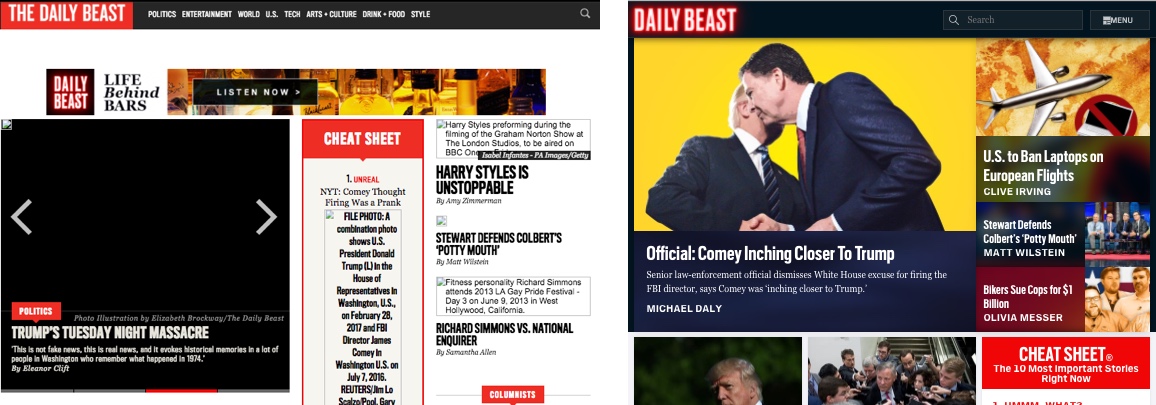Save 50% on a 3-month Digiday+ membership. Ends Dec 5.
The Daily Beast has been looking for ways to build deeper relationships with its brand advertisers. To do it, it had to take an axe to its most powerful traffic magnet, the homepage, which the Beast’s editor-in-chief, John Avlon, says attracts over 40 percent of its monthly visitors.
In a redesign unveiled on Wednesday, that meant cutting the number of articles on the page by one-third, ditching its third-party content widget and redesigning its CMS so it can share sponsored content in the form of swipeable cards, rather than just text or video, a format that’s now en vogue for a growing number of brands and advertisers.
While the overhaul has only been tested on small pockets of readers over the past few weeks, early returns show the changes haven’t hurt visits yet. Readers are consuming the same amount of content and clicking through the same number of pieces, and the revenue the publisher earns from each visitor hasn’t dipped. As the new native ad formats they’ve made room for start selling, the IAC-owned publisher hopes it can boost its revenue per visit considerably, as well as respond more nimbly to advertiser demands.
“We want to get to the place where we can react to the analytics we’re getting and adapt,” said Ken Judy, the Beast’s chief product and technology officer. “The homepage is the final significant piece of re-platforming.”
Even in this era of distributed content and endless platform expansion, the Beast still gets 44 percent of its monthly traffic from direct visits. That success made the product team leery of changes. Loyal readers loved its design, a newspaper-inspired patchwork of boxes that hadn’t been changed in over four years.

But that design also limited the kinds of inventory it could sell to advertisers, and it wanted to ensure it could continue to sell what advertisers wanted to buy. The lion’s share of the Beast’s revenue comes from premium, direct-sold ads, followed by programmatic, a company spokesperson said. It declined to give hard percentages or specific revenue figures. “We needed to make it more of a premium spot for brands,” Judy said.
To that end, the Beast completely overhauled its CMS, making it easier for its writers to produce stories that incorporate multimedia and interactive assets. On the old CMS, if a writer wanted to add any kind of interactive element, like a map or a chart, the Beast’s engineering team would have to get involved.
The Beast shrank the number of stories visible on the homepage as well, giving them bigger images and a blurb area. The smaller number of boxes are also grouped differently, into categories that Judy said advertisers can either sponsor or fill with sponsored content of their own.
The Beast also got rid of an Outbrain-powered third-party content widget, which Judy eliminated after his team analyzed how its homepage users behaved during visits. “Because so much of our traffic is loyal users, they’re really using our homepage to navigate our site,” Judy said. “We’ve determined that the most valuable thing is to get them to click into more content on our site.”
Oh, and it got rid of the old logo, too, switching to a neon sign-inspired look that per Avlon, signals that the Beast “never sleeps.”
Judy said the completed redesign will also allow the Beast to re-evaluate its ad stack, with the goal of ensuring the third parties that power its programmatic display revenues aren’t slowing its site down. “Now we can go into the business of optimizing,” he said.
More in Media

‘The Big Bang has happened’: Reach gets proactive on AI-era referrals, starting with subscriptions
This week, the publisher of national U.K. titles Daily Mirror, Daily Express and Daily Star, is rolling out its first paid digital subscriptions – a big departure from the free, ad-funded model it’s had throughout its 120-year history.

Arena Group, BuzzFeed, USA Today Co, Vox Media join RSL’s AI content licensing efforts
Arena Group, BuzzFeed, USA Today Co and Vox Media are participating in the RSL Collective’s efforts to license content to AI companies.

Marketers move to bring transparency to creator and influencer fees
What was once a direct handoff now threads through a growing constellation of agencies, platforms, networks, ad tech vendors and assorted brokers, each taking something before the creator gets paid.





